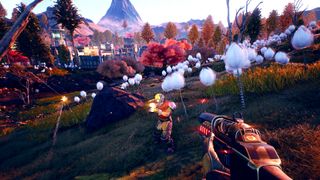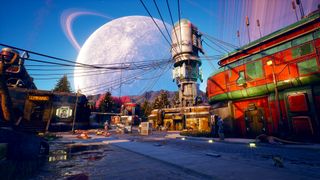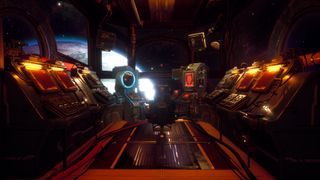Obsidian's The Outer Worlds blends Firefly and Fallout into a bold, open-ended sci-fi RPG
The creators of the original Fallout have spent two years on a new first-person RPG, and it looks great.
Obsidian's new RPG The Outer Worlds is not just sci-fi: it is exuberantly sci-fi. Blood red trees pepper valleys of strange cylindrical rocks and alien shrubs. A spaceship rumbles overhead, coming in for a landing at the nearest spaceport. Rings grander than Saturn's carve an arc across the horizon, and a field of stars shine impossibly bright in the afternoon sky. It's a world I already know I want to explore: the colorful vistas of No Man's Sky, but in an RPG that looks and feels very Fallout, just a million miles away and pre-nuclear armageddon.
The Outer Worlds looks like exactly the game anyone disappointed in Fallout 76's multiplayer focus will want to play.
It's an incredibly good time to be the creators of Fallout. Not Bethesda, the studio behind Fallout 3 and Fallout 4 and now the disappointing Fallout 76: It's a bad time to be Bethesda, with new Fallout 76 problems seemingly popping up every day. But it's a great time to be Tim Cain and Leonard Boyarsky, who designed the original Fallout and Fallout 2 in 1997/1998. From the hour of gameplay I saw in a recent demo at Obsidian's offices, The Outer Worlds looks like exactly the game anyone disappointed in Fallout 76's multiplayer focus will want to play: a first-person RPG shooter, with a focus on roleplaying above all else.
Call me the space cowboy
There are telltale signs all over that you're playing a game designed by Tim Cain and Leonard Boyarsky, if you know what to look for. One: there's never just a single path through a mission, but always the golden trifecta: fighting, talking, and sneaking. Two: a unique vibe stemming from what Boyarsky calls "the combination of my dark morbidity and Tim's silliness." Three: Bending over backwards to prioritize player choice in a world that's often silly, despite being all shades of gray.
"We can't seem to get away from it, not that we want to. That's what appeals to us," Boyarsky says. "The ability to not only make your own decisions, but also not having a clear-cut 'what is the best choice, here?' That's where players have to start really thinking, 'what do I want to do as a character, as opposed to 'I always play the good guy, so I'm always going to pick helping people.'"
After two years of secrecy, the leads were eager to show off their game. The demo started on the player's personal spaceship, which you'll acquire in the first act and then use to hop between locations on a pair of planets at the edge of humanity's settled systems. You're a bit out of place: you've been pulled out of cryosleep after what should've been a fatal amount of time on ice, and from there you'll be thrust into the midst of a bunch of corporations and outlaws vying for power.
"You were part of a ship that got lost," Boyarsky says. "You've been frozen for 70 years. If you're frozen for more than 10 years, it's a really bad thing. This guy figured out a way to save you, and he needs you to help him get more chemicals to help save the rest of the colonists. But you don't have to help him do that. You can go to the 'evil board,' the Halcyon corporate board, and turn this guy in and see what happens if you do that."
"You get a lot of money," Cain adds.
The biggest gaming news, reviews and hardware deals
Keep up to date with the most important stories and the best deals, as picked by the PC Gamer team.
One of the two main planets has been terraformed and is kinder to human life, while the other hasn't, making it home to more (and more dangerous) alien predators. Your ship will serve as a home base for you and your companions, much like Mass Effect's Normandy. You'll be able to chat with them and pick up companion quests, as they all have their own reasons for tagging along with you.
In an hour demo of The Outer Worlds, I watched them head to a small frontier town to respond to a distress call, then take a mission from a scientist to retrieve his previous research into hunger-suppressing toothpaste. Like everyone else in Outer Worlds, he works for a corporation: Everything is branded, and the megacorporation that sells you lunch is likely also manufacturing weapons or drugs.
"The idea that the game has been built around is that there's silly stuff and there's dramatic stuff, but it's not always like this separate thing," Boyarsky says. "This seems very silly, and hopefully humorous on the surface of it. They're making diet toothpaste, but this relates to a much bigger thing that's going on in the world."
Getting that research back involved sneaking into a facility, shooting some monsters that have gotten loose, and convincing the facility's guards that you're on their side... which led to their grisly death at the hands of some bandits patrolling outside.

This isn't RPG combat with dice rolls governing whether your perfectly aimed shots hit or miss
Of course, it didn't have to play out like that. You could shoot your way in instead of sneaking, not bother talking to the guards, or actually ally up with them instead. Or you could promise to help a captured outlaw in the facility, then betray her. Opportunities for double-crossing abound.
The art style and gunplay of The Outer Worlds had me thinking of Bioshock again and again. It's hard to say until I get my hands on it, but the animation and impact of shooting look slightly stiff and simple, in the way shooter-RPGs often do compared to a Battlefield or Rainbow Six: Siege. But that didn't stop it from looking fun, with tons of choices to make both in how you approach combat and what weapons you use.
There are weapons that use light, medium and heavy bullet ammo, as well as energy weapons and melee. I saw two of the latter, a lightsaber-esque sword with a green laser blade, and a scythe with a sick, dripping blade of red energy fit for a sci-fi grim reaper. The damage you do will be based both on the stats of that particular weapon and your character stats.
Like in BioShock, weapons are moddable to do fire damage, shock damage, and so on, but you can also upgrade them to higher damage tiers. There's a nice zip to laser weapons and all the graphical effects look great, like they're straight out of a modern pulp sci-fi serial.
While your character has stats that affect damage, this isn't RPG combat with dice rolls governing whether your perfectly aimed shots hit or miss. Line up a headshot, and it'll hit. But for players who care more about the roleplaying than the shooting, the developers came up with a "time dilation" mechanic akin to Fallout's VATS. You can slow down time to help you aim, and while time's dilated a bit of UI pops up next to the enemy you're aiming at with info like their HP. It's an easy way to target individual body parts, though aiming is still manual, unlike in VATS.
One of the last features they showed us in detail is a new system called "flaws," which Cain says he's wanted to put into a game for years. Flaws are optional character traits you can accept after something happens in the game. For example, after fighting a group of vicious space dogs called Raptidons, you might get the option to take the flaw Raptiphobia, which will make you weaker in fights against them from that point on. Flaws are permanent, and you can have up to three of them (or five on a harder difficulty), but of course there's a trade-off: you get to take an extra perk immediately.
"A flaw can be a fear of heights. There's my favorite, robophobia. We also have afraid of the dark. The game may go 'hey, you seem to catch on fire on fire a lot. Would you like to be susceptible to flame damage? If so, you can have another perk right now."

Whole new worlds
A lot of the map is opened up right after you get your ship, so you don't have to follow the story immediately,
Leonard Boyarsky
The area housing the research facility wasn't a narrow, linear path: there was definitely room to roam, with enemies and other locations to loot around the map. Outer Worlds isn't one massive contiguous world like today's open world games, but from what I've seen, that's a good thing. This is not a game made by 800 people, and the smaller environments look intimately hand-crafted, but are still big enough to hold sidequests and reward exploration.
One of the most exciting things the developers talked about was the freedom they're trying to bake into The Outer Worlds. "A lot of the map is opened up right after you get your ship, so you don't have to follow the story immediately," Boyarsky says. "There are points of no return, but we like to keep your options open for as long as possible."

There's a degree of level scaling on enemies, but within limits, which means you'll be able to travel to difficult places early, if you want, and reap the rewards--if you don't die. It looks and feels like a proper, open-ended PC RPG, but on a more conservative budget than today's blockbusters. I've only seen a small slice, so it's hard to say how unique the many paths through the game will feel, how rewarding it will be to take the "wrong" way and carve your own path.
But the setting has an invigorating freshness and personality to it for this type of game, and I think it's high time we got a campier, more sarcastic Firefly to Mass Effect's wannabe Star Trek.
Here are some other things I learned about The Outer Worlds:
- It's out in 2019
- It's an Unreal Engine 4 game
- Your protagonist isn't voiced
- There's a special class of "science weapons" that will have special, ridiculous effects, like a shrink ray
- There's a full character creator even though it's first-person only (you'll see your character in the inventory, and if you leave the game idling long)
- Your companions don't have separate inventories. Taking companions with you just gives you more inventory space to work with yourself
- If companions really dislike the decisions you make, they'll leave and go back to the ship. You can persuade them to see things your way
- No romancing companions. They considered it, but decided against it.
- Companions each have a special attack (one named Felix does a double drop kick) but you can also equip them with whatever weapons you want
- Hacking and lockpicking don't have minigames, and are simply based on your attributes
- There are six skills (strength, intelligence etc.) and for every 20 points you put into one (up until 100) you'll gain a new perk
- As in the creators' past games, you can play as a "dumb" character with stupid dialogue options. Your companions react appropriately.
- They're still not sure if it will be possible to play through the game completely pacifist (but you'll almost definitely have to at least kill some robots)
- Robots aren't sentient, but your ship's AI seems to have a strange degree of personality
- Tim Cain wants you to know there are a lot of drugs, but he's not going to pressure you to take them

Wes has been covering games and hardware for more than 10 years, first at tech sites like The Wirecutter and Tested before joining the PC Gamer team in 2014. Wes plays a little bit of everything, but he'll always jump at the chance to cover emulation and Japanese games.
When he's not obsessively optimizing and re-optimizing a tangle of conveyor belts in Satisfactory (it's really becoming a problem), he's probably playing a 20-year-old Final Fantasy or some opaque ASCII roguelike. With a focus on writing and editing features, he seeks out personal stories and in-depth histories from the corners of PC gaming and its niche communities. 50% pizza by volume (deep dish, to be specific).
Most Popular


